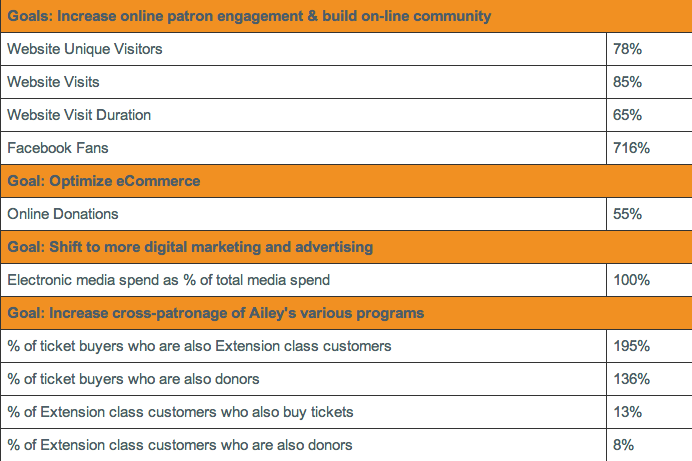In an article recently released by Nonprofit Quarterly, Rick Cohen argues that with technology now an integral part of life, it is natural that people want to monitor the impact of their activities with and contributions to a non-profit in much the same way. The idea of creating a data-informed culture that reflects the large-scale integration of technology and human behavior is well-established. Many arts organizations want to develop this culture, but are unsure how to begin. The case of Alvin Ailey American Dance Theater demonstrates that by clearly articulating overarching organizational goals, technology and the data that it collects can be leveraged as valuable information to move your arts organization toward success.
In 2007, the Alvin Ailey American Dance Theater was one of ten grantee organizations of Leading for the Future (LFF), a program of the Nonprofit Finance Fund designed to propel performing arts organizations forward by providing change capital. Alvin Ailey determined that its overarching goal was to utilize its award to establish a cross-departmental patron database to more effectively track patron activity and encourage more holistic patron engagement with the organization. The program was built on the belief that centralized patron management would lead to deeper patron engagement and increased audience retention across the company’s programs.
Alvin Ailey consists of two dance companies: a professional training academy, and a dance and fitness program. Prior to LFF, each arm of the company had its own processes to maintain patron information. After articulating a unified patron engagement goal, Alvin Ailey identified three major initiatives that utilized technology platforms to achieve those goals:
- Create a central patron database that spans all of its programs.
- Redesign its website to add more interactive content and increase functionality.
- Develop web-based analytics to monitor patron behavior and measure the links between patron engagement and revenue.
At the time the plan was implemented, Alvin Ailey created 34 different metrics to measure its goals. By the end of the four-year plan (2011), Alvin Ailey experienced a 716% increase in Facebook fans, a 136% increase in ticket buyers who are also donors, and a 55% increase in online donations. The chart below, from the Nonprofit Finance Fund, shows the percent change in evaluation metrics from the baseline (2007, pre-grant) to 2012.
Percent changed in categories between 2007 and 2012, produced by the Nonprofit Finance Fund
As part of the implementation, Alvin Ailey invested in creating a networked culture across the organization. Throughout LFF, it continuously tested new ideas for revenue growth, collecting and studying information to guide decisions and reinforce the direction of the program, a concept known as continuous improvement. For example after learning that 21% of website visitors accessed the site via mobile devices, Alvin Ailey decided to invest in mobile web technology so that patrons can more easily access the organization’s information. In addition, after analyzing feedback on email subject lines, Alvin Ailey adjusted its emailing practices to work toward more deeply engaging patrons.
Though many organizations may not have the opportunity to take advantage of an opportunity like Leading for the Future, any arts organization can work toward becoming more data-informed by taking existing overarching goals, asking how technology can help move the organization forward, and developing a plan to implement that technology. Executing this process repeatedly over time will ultimately create a more networked and engaged organization.
How has your arts organization encouraged a data-informed culture? What roadblocks have you encountered? What has been key to your success?



